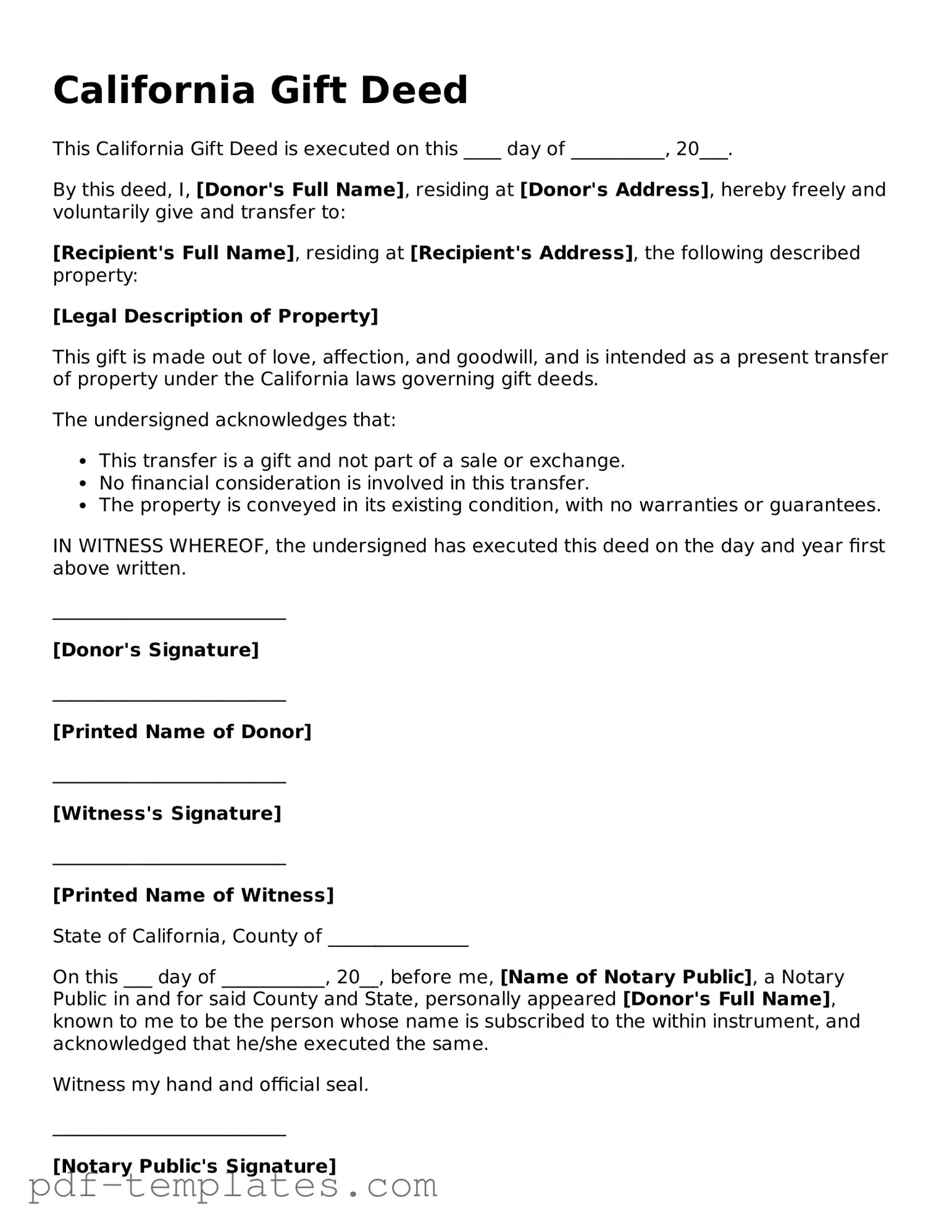The California Gift Deed is often compared to a Quitclaim Deed. Both documents serve the purpose of transferring property, but they differ in intent and the nature of the transfer. A Quitclaim Deed conveys whatever interest the grantor has in the property without any warranties regarding the title. It is commonly used among family members or in situations where the parties trust one another. In contrast, a Gift Deed explicitly indicates that the transfer is a gift, which can have tax implications and signifies a more formalized intent to relinquish ownership without compensation.
Another document similar to the Gift Deed is the Warranty Deed. While both serve to transfer ownership, a Warranty Deed provides a guarantee that the grantor holds clear title to the property and has the right to transfer it. This type of deed protects the grantee against future claims to the property. Unlike the Gift Deed, which does not offer such protections, a Warranty Deed is often used in sales transactions where the buyer seeks assurance regarding the property's title.
The Bargain and Sale Deed also bears similarities to the Gift Deed. This type of deed transfers property without any warranties against encumbrances, much like a Quitclaim Deed. However, it implies that the grantor has some interest in the property. In the context of a Gift Deed, the intent is to give the property freely, while a Bargain and Sale Deed suggests a more transactional nature, even if no money changes hands.
A Leasehold Deed is another document that can be likened to a Gift Deed, particularly when it involves transferring the rights to use a property for a specified period. While a Gift Deed transfers full ownership, a Leasehold Deed grants temporary rights to the lessee. The intent behind both documents can reflect a desire to provide access or benefits to another party, though the nature of the rights conveyed differs significantly.
For those interested in a rewarding career with Trader Joe's, completing the application form is essential and can be found at https://documentonline.org/blank-trader-joe-s-application/. This form serves as a key step in presenting one's qualifications and experiences, ultimately enhancing the likelihood of joining this beloved grocery chain.
The Joint Tenancy Deed is similar in that it can involve the transfer of property between parties, often family members. This deed creates a joint ownership structure where each party has equal rights to the property. While a Gift Deed typically involves a unilateral transfer with no expectation of return, a Joint Tenancy Deed indicates a shared ownership that could complicate the dynamics of property rights and responsibilities.
In some contexts, a Deed of Trust may also be compared to a Gift Deed. While fundamentally different in purpose—serving primarily as a security instrument for a loan—a Deed of Trust involves the transfer of property interests to a trustee for the benefit of a lender. In a sense, both documents involve the transfer of rights, but the Deed of Trust is more focused on securing obligations rather than gifting property outright.
The Special Warranty Deed is another document that can be likened to a Gift Deed. It conveys property with a limited warranty, meaning the grantor only guarantees the title against claims arising during their ownership. This contrasts with the full warranty of a Warranty Deed. While both documents facilitate the transfer of property, the Special Warranty Deed does not provide the same level of assurance to the grantee as a Gift Deed does regarding the intent of the transfer.
A Transfer on Death Deed (TOD) is similar to a Gift Deed in that it allows property to pass to a beneficiary without going through probate. This document enables the property owner to retain control during their lifetime while designating who will receive the property upon their death. Unlike a Gift Deed, which transfers ownership immediately, a TOD deed only takes effect after the owner's passing, reflecting a different approach to property transfer.
Lastly, a Revocable Living Trust can be viewed as a document related to the Gift Deed. Although it does not transfer property in the same manner, a Revocable Living Trust allows individuals to manage and designate their assets during their lifetime and beyond. Property placed in the trust can be distributed to beneficiaries without the need for probate, similar to how a Gift Deed facilitates the transfer of property directly to a recipient. Both documents reflect a desire to control the distribution of assets, albeit through different mechanisms.
